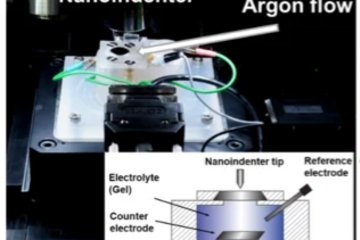All genres
81.
Journal Article
Dissolution of BiVO4 Photoanodes Revealed by Time-Resolved Measurements Under Photoelectrochemical Conditions. The Journal of Physical Chemistry 123 (38), pp. 23410 - 23418 (2019)
82.
Journal Article
Time-resolved analysis of dissolution phenomena in photoelectrochemistry – A case study of WO3 photocorrosion. Electrochemistry Communications 96, pp. 35 - 56 (2018)
83.
Journal Article
Eliminating deformation incompatibility in composites by gradient nanolayer architectures. Scientific Reports 8 (1), 16216 (2018)
84.
Journal Article
Microstructure evolution of FeNiCr alloy induced by stress-oxidation coupling using high temperature nanoindentation. Corrosion Science 135, pp. 192 - 196 (2018)
85.
Journal Article
Atomic-scale insights into surface species of electrocatalysts in three dimensions. Nature Catalysis 1 (4), pp. 300 - 305 (2018)
86.
Journal Article
Evaluation of EELS spectrum imaging data by spectral components and factors from multivariate analysis. Microscopy 67 (suppl_1), pp. i133 - i141 (2018)
87.
Journal Article
Ag-Segregation to Dislocations in PbTe-Based Thermoelectric Materials. ACS Applied Materials and Interfaces 10 (4), pp. 3609 - 3615 (2018)
88.
Journal Article
Superior solar-to-hydrogen energy conversion efficiency by visible light-driven hydrogen production via highly reduced Ti2+/Ti3+ states in a blue titanium dioxide photocatalyst. Catalysis Science & Technology 8 (18), pp. 4657 - 4664 (2018)
89.
Journal Article
Why Tin‐Doping Enhances the Efficiency of Hematite Photoanodes for Water Splitting - The Full Picture. Advanced Functional Materials 28 (52), 1804472 (2018)
90.
Journal Article
Tailoring Thermoelectric Transport Properties of Ag-Alloyed PbTe: Effects of Microstructure Evolution. ACS Applied Materials and Interfaces 10 (45), pp. 38994 - 39001 (2018)
91.
Journal Article
Large strain synergetic material deformation enabled by hybrid nanolayer architectures. Scientific Reports 7, 11371 (2017)
92.
Journal Article
Nonagglomerated Iron Oxyhydroxide Akaganeite Nanocrystals Incorporating Extraordinary High Amounts of Different Dopants. Chemistry of Materials 29 (17), pp. 7223 - 7233 (2017)
93.
Journal Article
Simultaneous optimization of electrical and thermal transport properties of Bi0.5Sb1.5Te3 thermoelectric alloy by twin boundary engineering. Nano Energy 37, pp. 203 - 213 (2017)
94.
Journal Article
Role of Nanostructuring and Microstructuring in Silver Antimony Telluride Compounds for Thermoelectric Applications. ACS Applied Materials and Interfaces 9 (17), pp. 14779 - 14790 (2017)
95.
Journal Article
Mo-doped BiVO4 thin films – high photoelectrochemical water splitting performance achieved by a tailored structure and morphology. Sustainable Energy & Fuels 1 (8), pp. 1830 - 1846 (2017)
96.
Journal Article
Difference in linear polarization of biaxially strained InxGa1-xN alloys on nonpolar a-plane and m-plane GaN. Physical Review B 92 (24), 245202 (2015)
97.
Journal Article
Interface structure and chemistry of GaN on Ge(111). Physical Review Letters 111 (25), 256101 (2013)
98.
Talk
New insights into thermoelectric materials through length-bridging characterization. Transverse Effects in Thermoelectric Systems 819. WE-Heraeus-Seminar, Bad Honnef, Germany (2024)
99.
Talk
Triggering and tracking grain boundary phase transformation at atomic resolution. European Microscopy Conference EMC 2024, Copenhagen, Denmark (2024)
100.
Talk
In situ STEM observation of thermoelectric materials under heating and biasing conditions. The 6th joint Sino-German workshop on advanced & correlative electron microscopy of catalysts, quantum phenomena & soft matter, Bad Honnef, Germany (2024)











